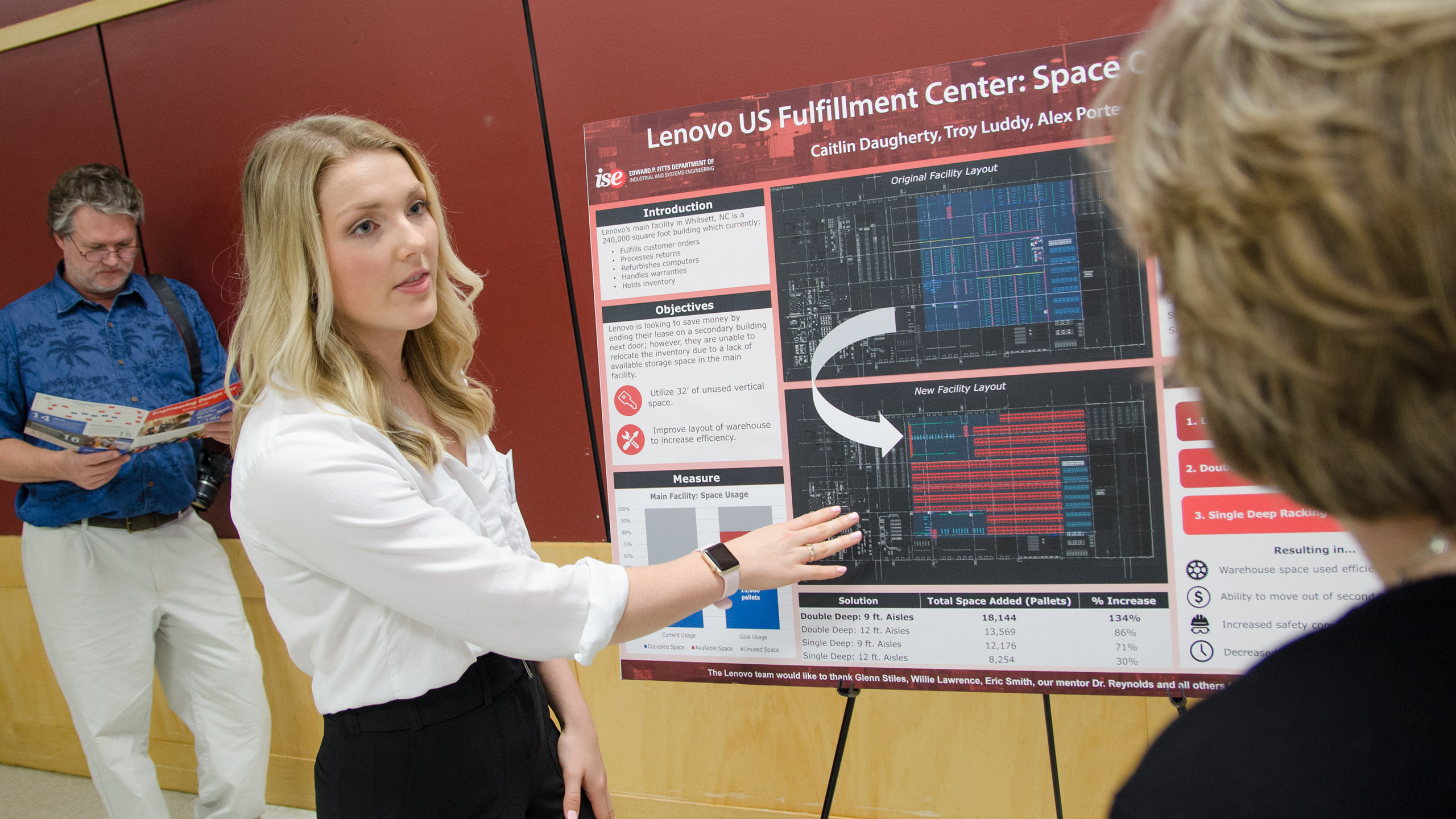Past Senior Design Projects

Past Senior Design Projects
Last Updated: 04/25/2025 | All information is accurate and still up-to-date
Each semester, you can partner with us through our Senior Design Program. In this program, you work directly with student teams on real-world projects. You gain fresh ideas and creative energy from future engineers through this collaboration. At the same time, students learn by solving real challenges your business faces. As a result, both you and the student team benefit from the experience. Your sponsorship helps shape the next generation of problem solvers. We truly appreciate your past support and look forward to working with you again.
Spring 2025 | Photo Gallery

Engineered Controls International
Student Team: Emily Berg, Matthew Madren, Nicholas Norris, and Elizabeth Putelo
Engineered Controls International (ECI) makes flow control devices for propane, natural gas and other industrial gases. With over 100 machines on-site, poor layout and weak material flow have slowed production.
To solve this, a senior design team built a better layout using a math model, considering space and machine locations. They also improved material handling by adding a staging area and an Andon light system. As a result, these updates reduce machine downtime, improve workflow and create a setup that can adapt as ECI grows.

Fleet Readiness Center – East
Student Team: Kyle Faulkner, Thatcher Fettig, Spencer Murray and Lukas Westberg
At the Fleet Readiness Center East (FRCE), creating Statements of Work (SOWs) for equipment purchases is a slow, manual process. Because of this, delays happen often, documents vary and mistakes in technical details are more likely.
To fix these problems, a senior design team built an automated system using Microsoft Office tools like Power Apps, Excel and Power Automate. First, they studied the old workflow and set up a system to classify different SOW types. Then, they made an interactive app to help users pick the correct specifications. As a result, this automation boosts accuracy, shortens processing time and improves document consistency. It also allows FRCE to stay ready for missions with greater speed and flexibility.

Herbalife
Student Team: Ben Blackburn, Ayush Bodhale, Christian Cox, Allison Dobyns and Liana Lessard
Herbalife, a dietary supplement company, faces long changeover times at its Winston-Salem HIM Plant. After time and motion studies, the ISE team found several types of waste slowing down the changeover process. Using historical data and study results, the team built an ROI tool, a future state process map and a Pareto Chart. With these tools, they identified strong opportunities for improvement. As a result, the team proposed changes that could cut changeover time by 20%, helping Herbalife work faster and more efficiently.

Hitachi Energy (Efficiency)
Student Team: Will Geiger, Hope Ketola, Joseph Sides, Logan Styers and Pamela Zuniga Rodriguez
Hitachi Energy is expanding its Power Transformer division to meet rising demand and clear a serious backlog. Because of this, they want to boost how many units they produce and make their process more efficient.
To help, the ISE Senior Design Team created a future state layout that used space better and improved production flow. First, they ran simulation tests using different machine setups to find the best arrangement. Then, they picked the setup that best matched Hitachi’s goals for the final layout. As a result, this plan supports faster production and better use of resources.

Hitachi Energy (Waste)
Student Team: Maddie Billings, Sophia Lloyd, Grace Newman and Audrey Westlund,
Hitachi Energy’s South Boston, Virginia, plant is working toward an ambitious goal: achieving zero waste to landfill by 2030. With a strong commitment to sustainability, the plant is exploring opportunities to improve waste sorting and reduce environmental impact across operations.
To support this mission, this senior design team developed a Zero Waste Contamination Strategy focused on reducing cardboard contamination, one of the primary obstacles to landfill diversion. Targeting high cardboard-producing subprocesses, the team proposed solutions including an optimized waste receptacle layout, improved signage, and an economic analysis for a cardboard compactor. These recommendations aim to increase recycling effectiveness and provide a foundation for broader plant-wide adoption.

NC State COE
Student Team: Lucas Barbu, Nick Harvey, Brett Olson and Curt Verchick
As NC State’s College of Engineering tried to boost sponsored funding, it became clear the current process needed review. The Research Administration department couldn’t keep up with the rising number of submitted grant proposals.
To fix this issue, the senior design team stepped in to improve how things worked. Their main goal was to build tools to help staff review and finish proposals before sending them to funding agencies. Along the way, the team used new artificial intelligence methods to cut down on delays and extra steps. As a result, they gained the ability to handle and complete more grant proposals than in past years.

NC State EPSI
Student Team: Emily Cox, Caroline Cranor, Justin Drake and Jane Steighner
Automated External Defibrillators (AEDs) save lives during cardiac arrest, but problems with their placement, visibility and maintenance exist across campus. Because of this, a senior design team partnered with the Emergency Preparedness and Strategic Planning (EPSI) department to find solutions.
First, the team created new signage and built a maintenance schedule to address major gaps. Then, they developed location recommendations to make AED and signage placement more consistent and easier to find. Finally, they started conversations with the student government to boost outreach. As a result, these efforts highlight the importance of AEDs and raise community awareness.

NC State WRR
Student Team: John Duer, David Mahar, Michael Monaco and Billy Schick
Currently, 70% of the waste from NC State football games is in the landfill. To change this, a senior design team partnered with the Zero Waste Wolfpack (ZWW) to boost diversion rates.
Using data and examples from other schools, the team built a five-year plan to help NC State lead in sustainable athletics. First, they suggested improving waste sorting and making zero-waste stations and signs easier to use. They also recommended growing volunteer engagement and training and requiring compostable or recyclable serviceware. As a result, these steps could make NC State a model for athletic sustainability.

Novo Nordisk
Student Team: Juan Balderas, Stanley Haviland, Zachary Jones, Danielle Lewis and Meredith Padgett
In early 2025, Novo Nordisk’s Durham, NC, facility expanded to produce Rybelsus tablets for diabetes, which brought new inventory challenges. Poor storage, random ordering and weak tracking caused delays and crowded the warehouse.
To fix these problems, a senior design team created a three-part plan. They introduced an ordering system linked to SAP, improved vertical storage and built a smart tracking tool. By using data analysis, clear workflows and risk prevention, the team supports the July 2025 launch of Generation 2 Rybelsus. This effort also helps Novo Nordisk save money, work more efficiently and keep production on track.

Novo Nordisk HFC
Student Team: Chase Drizake, Ryan Gibson, Amber Locklear and John McLoughlin
Hydrofluorocarbon (HFC) refrigerants are often used in industry because they are stable and have low toxicity. However, they are powerful greenhouse gases that harm the climate much more than carbon dioxide. Because of this major impact, new global rules require companies like Novo Nordisk to remove HFCs from their facilities.
To meet this need, a senior design team built a complete phase-out plan. First, they picked the best alternative refrigerant by looking at environment, health and safety, cost and availability, business risk and maintenance needs. As a result, their final plan balances costs, reduces environmental harm and keeps business operations running smoothly.

Pentair
Student Team: Matt Bogdan, Tatsu Mahiko, Daniel Peeler, Lydia Stucker and James Wilt
Pentair saw a need to improve how it collects hourly production data to speed up decision-making. To help, a senior design team built an automated platform that improves real-time tracking across 13 of Pentair’s manufacturing lines. First, the ISE team created a process to collect hourly data and generate reports automatically for quick decisions. Then, they digitized Pentair’s Pareto charts to track quality and cost metrics more easily.
As a result, this new system removed an inefficient step and now drives faster, smarter improvements in Pentair’s operations.

Tuffy’s Chicken Kitchen
Student Team: Caroline Colwell, Mana Mirsadeghi, Jenny Olguin-Garay, Mac Patterson and Nick Steinlage
Tuffy’s Chicken Kitchen is a biotechnology company that uses cultivated meat to meet the rising global need for protein. In their process, a nutrient-rich media helps cells grow and must pass through a two-step filtration before entering a bioreactor. Right now, the filters are single-use, which causes high costs and long labor hours for replacements. Because of this, operating expenses stay high and efficiency remains low.
To fix this, the project focuses on extending the life of the filters. As a result, Tuffy’s Chicken Kitchen can lower costs, improve efficiency and boost the sustainability of protein production.

Union Special
Student Team: Lanai Adams, Parker Dotson, Ty Frankosky and Shiv Hira
Union Special Bread, a wholesale and retail bakery planning to expand into a new facility, faces rising labor costs and process delays in its prep and packaging room.
To solve these issues, a senior design team carefully studied the room’s layout, work patterns and equipment use. As a result, they introduced new breadbaskets, clear standard procedures and a better room setup. These changes quickly reduced wasted time, improved how tools were organized and lowered costs. Overall, these updates support future growth, improve efficiency and reduce wasted materials and time.
